Unlock the Full Value of FinOps
By enabling safe, continuous optimization under clear policies and guardrails
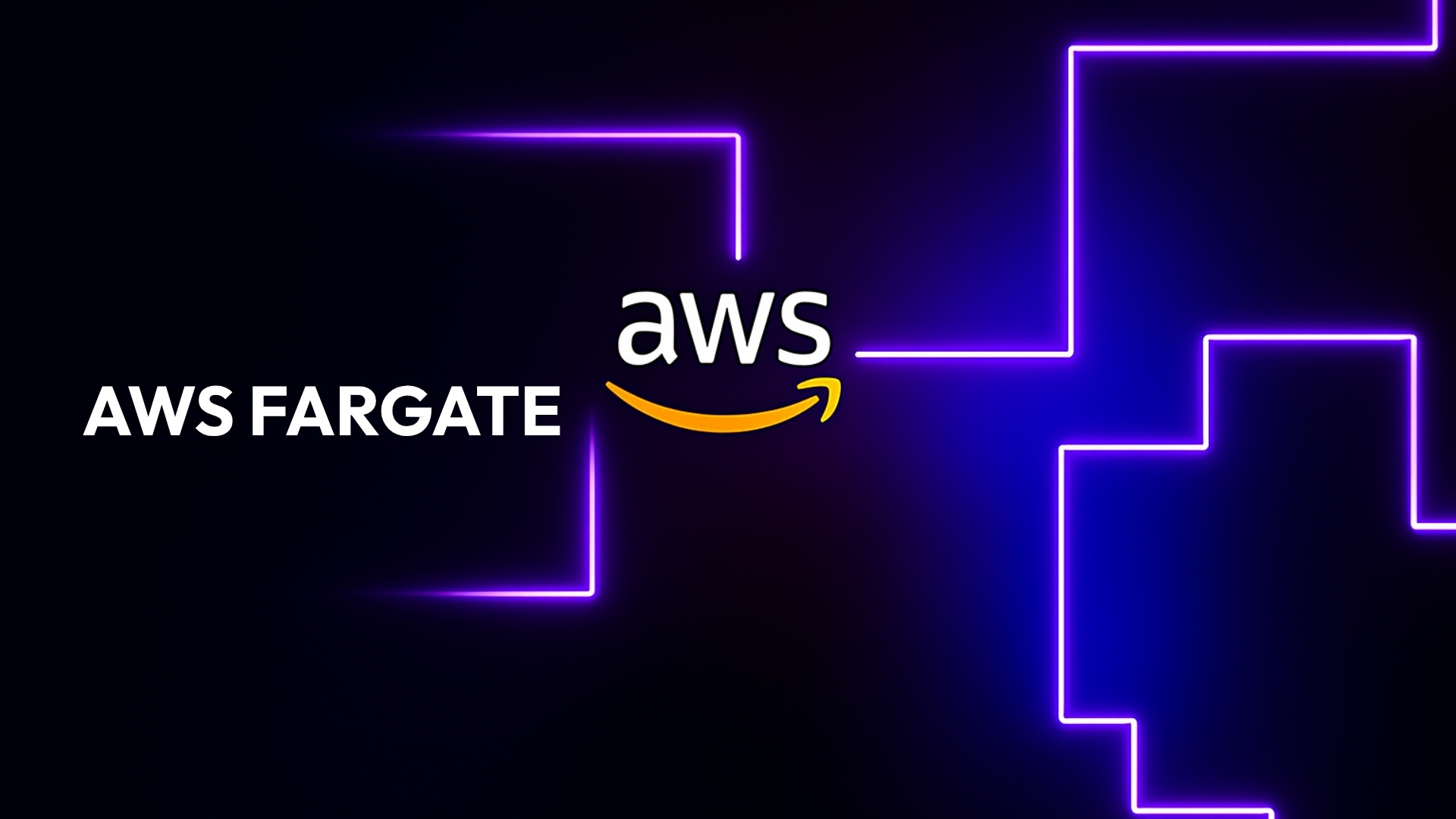
November 6, 2025
November 5, 2025
November 6, 2025
November 5, 2025

AWS Fargate is a serverless compute engine that enables teams to run containers without managing underlying infrastructure, offering automatic scaling, flexible resource configurations, and deep integration with AWS services like ECS and EKS. It simplifies operations by abstracting infrastructure management, making it ideal for microservices, event-driven workloads, and batch processing. Fargate uses a pay-per-use pricing model based on vCPU, memory, and storage consumption, with options like Savings Plans and Fargate Spot for cost optimization. However, Fargate can be more expensive for steady-state workloads and lacks GPU support, making it unsuitable for certain high-performance applications.
Engineering teams need flexible ways to run containerized applications without spending valuable time on server maintenance. AWS Fargate is Amazon’s serverless compute engine that runs containers on Amazon ECS and Amazon EKS. Since its launch in 2017, it has freed teams from the burden of provisioning, patching, and scaling EC2 instances.
In 2025, serverless adoption is accelerating. Gartner forecasts that more than 50% of container deployments will use serverless container services such as Fargate by 2027. For engineering leaders, this isn’t just an industry forecast. It’s a clear signal that your teams will need to understand what Fargate does well, where it falls short, and, critically, how much it costs before betting workloads on it.
This guide explains Fargate’s architecture, features, benefits, and limitations. We break down pricing models, compare Fargate with EC2 and Lambda, share best practices for cost optimization, and examine future trends.
AWS Fargate is a serverless compute engine built into Amazon Elastic Container Service (ECS) and Amazon Elastic Kubernetes Service (EKS). Instead of provisioning EC2 instances and managing clusters, engineers specify CPU and memory requirements for each task or pod. Fargate then launches lightweight Firecracker micro‑VMs to run container workloads securely, handles scaling, and ensures isolation.
A Fargate task or pod can run Linux or Windows containers, integrate with AWS Identity and Access Management (IAM) and other AWS services, and automatically scales with demand. Because the server infrastructure is fully managed, teams pay only for the vCPU, memory, and storage configured for each running task.
It’s common to confuse Fargate with AWS ECS. ECS is a container orchestrator that schedules, deploys, and scales containers. Fargate is a launch type or runtime within ECS and EKS that eliminates the need to manage EC2 instances. When launching tasks, teams choose between the EC2 launch type (self‑managed instances) and the Fargate launch type (serverless). EKS adds Fargate profiles to run Kubernetes pods with Fargate.
Also Read: Understanding Amazon ECS
Before we discuss pricing or optimization, it’s worth grounding ourselves in the structure of AWS Fargate. These components form the backbone of how AWS Fargate delivers scalable, efficient, and cost-effective serverless container management:
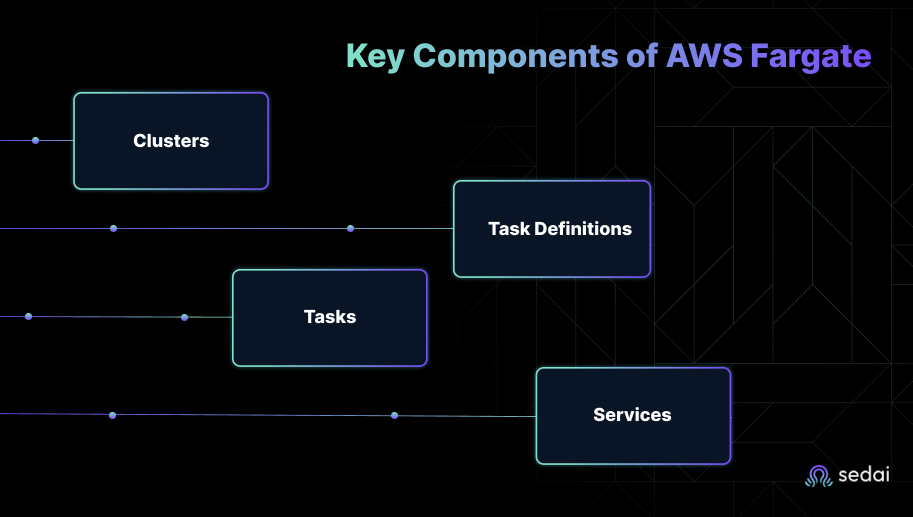
1. Clusters
Clusters are logical groupings that help organize tasks and services in AWS Fargate. They simplify resource management by grouping related tasks together, ensuring better organization and scalability.
2. Task Definitions
These are JSON files that describe how containers in a task should run, including Docker images, resources like CPU and memory, and networking configurations. Task definitions act as blueprints, guiding Fargate on how to deploy the containers.
3. Tasks
Tasks are instances of a task definition running in Fargate. They are the units of compute that carry out the work, running your containerized application on the cluster.
4. Services
Services ensure the desired number of tasks are running and manage scaling based on traffic demand. They automatically replace failed tasks and are responsible for maintaining high availability, often integrating with load balancers to distribute traffic evenly across tasks.
What matters here isn’t memorizing each component, but understanding how little of the underlying infrastructure you can influence. Fargate abstracts so much away that the only real levers left to pull are task sizing, service configuration, and scaling policies. That simplicity is its biggest strength, but also where engineering leaders need to tread carefully. It’s easy to overspend when the knobs you once relied on are gone.
AWS Fargate is marketed as a way to “forget about servers,” but under the hood, what you’re really getting is a curated set of features designed to abstract infrastructure while still giving you just enough knobs to avoid feeling locked in. Here’s what matters most to engineering teams evaluating it:
These features allow teams to tailor compute environments per service while avoiding underlying server management. The engineering challenge isn’t whether these features work (they do), but whether the cost profile aligns with the scale and variability of your workloads.
Under the hood, Fargate uses Firecracker micro‑virtual machines to isolate each task or pod. By abstracting away the underlying infrastructure, Fargate allows developers to focus solely on their applications. Here's an in-depth look at how it operates:
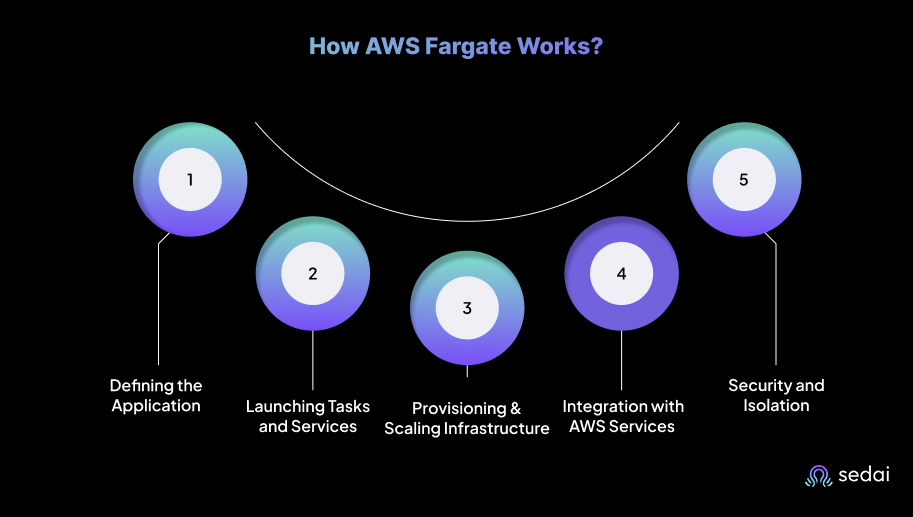
To begin, developers define their application using a task definition. This JSON-formatted file specifies:
This task definition serves as a blueprint for launching containers within Fargate.
Once the task definition is in place, developers can launch:
Fargate manages the placement and execution of these tasks, ensuring they run in isolated environments with the specified resources.
When a task is launched, Fargate automatically provisions the necessary compute resources. It handles:
This serverless approach eliminates the need for manual infrastructure management.
Fargate seamlessly integrates with various AWS services to enhance functionality:
These integrations enable the creation of robust, scalable, and secure applications.
Fargate ensures that each task operates in its own isolated environment. This isolation provides:
This managed lifecycle allows engineering teams to focus on application logic rather than infrastructure operations. However, the abstraction hides host access, which can complicate debugging.
AWS Fargate is designed to minimize the complexity of container management by automating infrastructure provisioning, scaling, and management. With Fargate, you can focus on application development while AWS handles the backend complexity. This results in greater agility, reduced overhead, and cost predictability.
Here are the key benefits that Fargate brings to engineering teams:
Despite its many benefits, AWS Fargate does have a few limitations, especially for certain types of workloads. While Fargate excels in event-driven, batch, or intermittent workloads, it may not be the best fit for high-performance or always-on applications due to higher costs and specific functionality gaps.
Understanding these limitations helps teams determine when to leverage Fargate and when to consider other AWS services like EC2. Here are the key limitations to consider:
Despite these limitations, Fargate remains attractive for many event‑driven, batch, or intermittent workloads where operational efficiency and agility outweigh the higher per‑unit cost.
Understanding the pricing models and components of AWS Fargate is crucial for making cost-effective decisions for containerized applications. AWS Fargate offers flexibility, scalability, and operational efficiency, but knowing how its pricing works can help engineering leaders optimize costs based on their usage patterns.
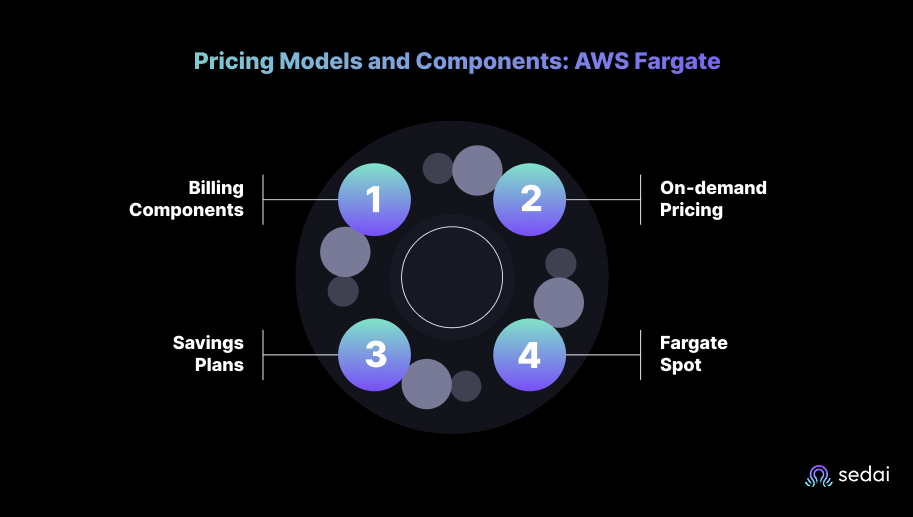
Fargate pricing has three primary levers:
Additional charges include data transfer, Elastic IP addresses, and AWS ECR storage. Fargate with Windows containers and Graviton processors has slightly different rates; always check AWS’s pricing page for the latest numbers.
The complete price list for all regions is available here.
On‑demand is the default model. You pay only for the configured vCPU and memory while tasks are running. In the US West (N. California) region, on‑demand vCPU pricing is around $0.04656 per vCPU‑hour, and memory pricing is $0.00511 per GB-hour. Billing starts when a task is launched and ends when it stops. This works well for bursty or unpredictable workloads where pre-committing resources would lead to overprovisioning.
AWS Fargate offers Compute Savings Plans to help reduce costs in exchange for a commitment to consistent usage over a 1-year or 3-year period. This can offer substantial savings, particularly for steady-state workloads.
Here’s a breakdown of the savings:
These plans apply across Fargate, Lambda, and EC2 and are region‑agnostic. Teams should estimate steady-state usage to determine whether Savings Plans offer a better value than the flexibility of on-demand pricing.
Fargate Spot offers steep discounts, around 70% off on‑demand prices, in exchange for potential interruptions. Spot tasks run on spare capacity and can be terminated with a two‑minute warning. They are ideal for fault‑tolerant workloads such as batch processing, CI/CD tasks, or background jobs. Fargate Spot tasks have no SLA, so design your application to handle interruptions gracefully.
Suggested Read: Cloud Optimization Services: What Engineering Leaders Need to Know
AWS Fargate offers more flexibility than EC2 and Lambda, making it an ideal choice for microservices, event-driven applications, and batch jobs. Fargate can be more expensive than EC2 instances for steady workloads, but shines in scalability and operational efficiency for bursty or dynamic workloads.
Below is a comparison of the pricing models and use cases:
Fargate sits between EC2 and Lambda: it offers more flexibility than Lambda (long‑running containers, custom runtimes) without the management overhead of EC2. However, for applications with steady, predictable workloads, EC2 instances with Savings Plans or Reserved Instances often provide better total cost of ownership. Many teams combine Fargate for spiky tasks with EC2 for baseline services.
AWS Fargate is particularly well-suited for:
From a cost and operational standpoint, Fargate’s real advantage emerges when workloads are dynamic. The combination of per-second billing, automated scaling, and tight integration with ECS/EKS allows teams to minimize overhead while maintaining resilience and high availability.
That said, for engineering leaders, it’s critical to pair Fargate with tools and processes that continuously monitor resource consumption. Without proactive rightsizing, even a serverless container can generate surprisingly large bills.
Fargate’s pay-per-use model rewards teams that pay close attention to sizing and resource allocation. From our experience managing containerized workloads at scale, the difference between a well-optimized Fargate deployment and a costly one often comes down to disciplined practices.
The future of serverless containers like AWS Fargate looks promising as the containers continue to evolve. Gartner predicts that 90% of organizations will adopt a hybrid cloud strategy by 2027.
Fargate's seamless integration with Amazon EKS positions it well to support hybrid workloads, making it an attractive option for businesses adapting to this trend. The real opportunity, however, lies not just in adopting serverless containers but in operationalizing them efficiently at scale.
Additionally, the serverless computing market is forecasted to grow at a compound annual growth rate (CAGR) of 14.15%, expanding from US$28.02 billion in 2025 to US$92.22 billion by 2034, with serverless containers playing a significant role in this expansion.
Widespread adoption of serverless containers is also on the horizon, with Gartner projecting that over 50% of global container deployments will shift to serverless platforms by 2027. This trend is driven by the increasing use of AI/ML workloads and edge computing applications, with estimates showing that 75% of AI workloads and 80% of edge applications will run in containers.
As AWS Fargate evolves with enhanced features like support for Graviton3 processors and GPU acceleration (currently in preview), it will become an even more powerful solution for managing workloads that require greater scalability and isolation.
Yet, the challenge remains: even with these advancements, teams still face fluctuating demand and the risk of over-provisioning. This is where autonomous optimization becomes indispensable. Platforms that continuously learn usage patterns, predict spikes, and adjust resources in real time allow teams to fully capture the operational and financial benefits of serverless containers.
When paired with mature FinOps practices, autonomous optimization enables engineering leaders to align cloud spend with actual business value, turning serverless containers into both a performance and cost advantage.
Also Read: Top FinOps Tools for Engineering Leaders in 2025
For engineering teams running containerized workloads at scale, the challenge isn’t just performance: it’s keeping cloud costs under control while maintaining reliability. Over the years, we’ve seen teams struggle with Fargate’s dynamic scaling: bursts of traffic can lead to over-provisioned tasks, while conservative sizing can throttle performance. Static alerts, manual tuning, and periodic reviews only address the problem after the fact.
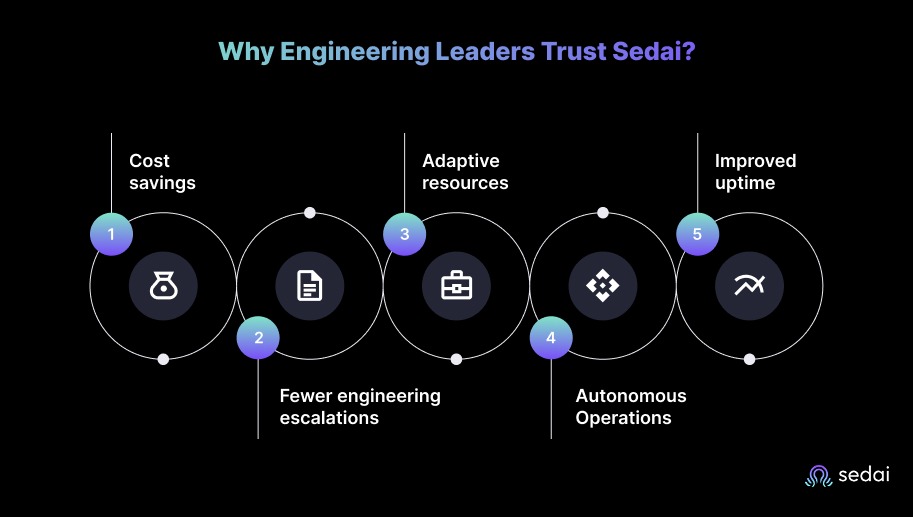
Alt text:Why Engineering Leaders Trust Sedai?
This is where autonomous optimization changes the game. Sedai’s self‑driving, autonomous cloud platform automates performance optimization and cost control for containerized workloads. Sedai uses AI to learn application patterns and proactively adjust resources.
Key advantages include:
By integrating this level of intelligence into everyday operations, engineering teams can make cost optimization a continuous, safe process rather than a periodic scramble. This approach turns cost management into a strategic tool, freeing teams to focus on delivering reliable, high-performance services while keeping spend in check.
AWS Fargate enables teams to run containerized applications without managing servers, enabling agility and security through isolation and per‑second billing. Its benefits: simplified operations, automatic scaling, and deep integration with AWS services make it ideal for microservices, event‑driven workloads, batch jobs, and hybrid deployments.
However, engineering leaders must remain aware of higher per‑unit costs, limited regional availability, and cold‑start latencies. By utilizing Graviton processors, Savings Plans, Spot pricing, and continuous rightsizing, teams can mitigate cost concerns and achieve strong price‑performance.
Serverless container adoption is accelerating. As Fargate matures, with improvements like GPU support and deeper hybrid‑cloud integration, its role in modern architectures will only grow. Platforms like Sedai amplify these benefits by automatically optimizing workloads across Fargate and EC2, delivering both agility and cost efficiency.
Gain full visibility into your AWS environment and reduce wasted spend immediately.
Not necessarily. Fargate eliminates infrastructure management and bills per second of vCPU and memory consumption, but the per-unit cost is often higher than EC2. Savings Plans and Fargate Spot can reduce costs significantly. For steady workloads with predictable capacity, EC2 instances using Reserved Instances or Savings Plans may be more cost‑effective. Many teams adopt a hybrid strategy: running baseline services on EC2 and bursty tasks on Fargate.
AWS Lambda is an event‑driven serverless function service. It bills per request and execution time and is designed for short‑lived functions. Fargate, by contrast, runs long‑running containers and bills based on vCPU and memory. Fargate offers more control over the runtime environment, including container images and networking, whereas Lambda simplifies code deployment for discrete functions.
Fargate Spot is ideal for jobs that can be interrupted, such as batch processing, CI/CD tasks, data transformation pipelines, and periodic scripts. It provides up to 70% cost savings compared with on‑demand pricing. However, tasks may be terminated with little notice, so they must be designed to handle interruptions (for example, by checkpointing progress).
Yes. Fargate supports both Linux and Windows containers. However, Windows container pricing is higher and not available in every region. Check AWS documentation for regional availability and pricing.
November 5, 2025
November 6, 2025

AWS Fargate is a serverless compute engine that enables teams to run containers without managing underlying infrastructure, offering automatic scaling, flexible resource configurations, and deep integration with AWS services like ECS and EKS. It simplifies operations by abstracting infrastructure management, making it ideal for microservices, event-driven workloads, and batch processing. Fargate uses a pay-per-use pricing model based on vCPU, memory, and storage consumption, with options like Savings Plans and Fargate Spot for cost optimization. However, Fargate can be more expensive for steady-state workloads and lacks GPU support, making it unsuitable for certain high-performance applications.
Engineering teams need flexible ways to run containerized applications without spending valuable time on server maintenance. AWS Fargate is Amazon’s serverless compute engine that runs containers on Amazon ECS and Amazon EKS. Since its launch in 2017, it has freed teams from the burden of provisioning, patching, and scaling EC2 instances.
In 2025, serverless adoption is accelerating. Gartner forecasts that more than 50% of container deployments will use serverless container services such as Fargate by 2027. For engineering leaders, this isn’t just an industry forecast. It’s a clear signal that your teams will need to understand what Fargate does well, where it falls short, and, critically, how much it costs before betting workloads on it.
This guide explains Fargate’s architecture, features, benefits, and limitations. We break down pricing models, compare Fargate with EC2 and Lambda, share best practices for cost optimization, and examine future trends.
AWS Fargate is a serverless compute engine built into Amazon Elastic Container Service (ECS) and Amazon Elastic Kubernetes Service (EKS). Instead of provisioning EC2 instances and managing clusters, engineers specify CPU and memory requirements for each task or pod. Fargate then launches lightweight Firecracker micro‑VMs to run container workloads securely, handles scaling, and ensures isolation.
A Fargate task or pod can run Linux or Windows containers, integrate with AWS Identity and Access Management (IAM) and other AWS services, and automatically scales with demand. Because the server infrastructure is fully managed, teams pay only for the vCPU, memory, and storage configured for each running task.
It’s common to confuse Fargate with AWS ECS. ECS is a container orchestrator that schedules, deploys, and scales containers. Fargate is a launch type or runtime within ECS and EKS that eliminates the need to manage EC2 instances. When launching tasks, teams choose between the EC2 launch type (self‑managed instances) and the Fargate launch type (serverless). EKS adds Fargate profiles to run Kubernetes pods with Fargate.
Also Read: Understanding Amazon ECS
Before we discuss pricing or optimization, it’s worth grounding ourselves in the structure of AWS Fargate. These components form the backbone of how AWS Fargate delivers scalable, efficient, and cost-effective serverless container management:

1. Clusters
Clusters are logical groupings that help organize tasks and services in AWS Fargate. They simplify resource management by grouping related tasks together, ensuring better organization and scalability.
2. Task Definitions
These are JSON files that describe how containers in a task should run, including Docker images, resources like CPU and memory, and networking configurations. Task definitions act as blueprints, guiding Fargate on how to deploy the containers.
3. Tasks
Tasks are instances of a task definition running in Fargate. They are the units of compute that carry out the work, running your containerized application on the cluster.
4. Services
Services ensure the desired number of tasks are running and manage scaling based on traffic demand. They automatically replace failed tasks and are responsible for maintaining high availability, often integrating with load balancers to distribute traffic evenly across tasks.
What matters here isn’t memorizing each component, but understanding how little of the underlying infrastructure you can influence. Fargate abstracts so much away that the only real levers left to pull are task sizing, service configuration, and scaling policies. That simplicity is its biggest strength, but also where engineering leaders need to tread carefully. It’s easy to overspend when the knobs you once relied on are gone.
AWS Fargate is marketed as a way to “forget about servers,” but under the hood, what you’re really getting is a curated set of features designed to abstract infrastructure while still giving you just enough knobs to avoid feeling locked in. Here’s what matters most to engineering teams evaluating it:
These features allow teams to tailor compute environments per service while avoiding underlying server management. The engineering challenge isn’t whether these features work (they do), but whether the cost profile aligns with the scale and variability of your workloads.
Under the hood, Fargate uses Firecracker micro‑virtual machines to isolate each task or pod. By abstracting away the underlying infrastructure, Fargate allows developers to focus solely on their applications. Here's an in-depth look at how it operates:

To begin, developers define their application using a task definition. This JSON-formatted file specifies:
This task definition serves as a blueprint for launching containers within Fargate.
Once the task definition is in place, developers can launch:
Fargate manages the placement and execution of these tasks, ensuring they run in isolated environments with the specified resources.
When a task is launched, Fargate automatically provisions the necessary compute resources. It handles:
This serverless approach eliminates the need for manual infrastructure management.
Fargate seamlessly integrates with various AWS services to enhance functionality:
These integrations enable the creation of robust, scalable, and secure applications.
Fargate ensures that each task operates in its own isolated environment. This isolation provides:
This managed lifecycle allows engineering teams to focus on application logic rather than infrastructure operations. However, the abstraction hides host access, which can complicate debugging.
AWS Fargate is designed to minimize the complexity of container management by automating infrastructure provisioning, scaling, and management. With Fargate, you can focus on application development while AWS handles the backend complexity. This results in greater agility, reduced overhead, and cost predictability.
Here are the key benefits that Fargate brings to engineering teams:
Despite its many benefits, AWS Fargate does have a few limitations, especially for certain types of workloads. While Fargate excels in event-driven, batch, or intermittent workloads, it may not be the best fit for high-performance or always-on applications due to higher costs and specific functionality gaps.
Understanding these limitations helps teams determine when to leverage Fargate and when to consider other AWS services like EC2. Here are the key limitations to consider:
Despite these limitations, Fargate remains attractive for many event‑driven, batch, or intermittent workloads where operational efficiency and agility outweigh the higher per‑unit cost.
Understanding the pricing models and components of AWS Fargate is crucial for making cost-effective decisions for containerized applications. AWS Fargate offers flexibility, scalability, and operational efficiency, but knowing how its pricing works can help engineering leaders optimize costs based on their usage patterns.

Fargate pricing has three primary levers:
Additional charges include data transfer, Elastic IP addresses, and AWS ECR storage. Fargate with Windows containers and Graviton processors has slightly different rates; always check AWS’s pricing page for the latest numbers.
The complete price list for all regions is available here.
On‑demand is the default model. You pay only for the configured vCPU and memory while tasks are running. In the US West (N. California) region, on‑demand vCPU pricing is around $0.04656 per vCPU‑hour, and memory pricing is $0.00511 per GB-hour. Billing starts when a task is launched and ends when it stops. This works well for bursty or unpredictable workloads where pre-committing resources would lead to overprovisioning.
AWS Fargate offers Compute Savings Plans to help reduce costs in exchange for a commitment to consistent usage over a 1-year or 3-year period. This can offer substantial savings, particularly for steady-state workloads.
Here’s a breakdown of the savings:
These plans apply across Fargate, Lambda, and EC2 and are region‑agnostic. Teams should estimate steady-state usage to determine whether Savings Plans offer a better value than the flexibility of on-demand pricing.
Fargate Spot offers steep discounts, around 70% off on‑demand prices, in exchange for potential interruptions. Spot tasks run on spare capacity and can be terminated with a two‑minute warning. They are ideal for fault‑tolerant workloads such as batch processing, CI/CD tasks, or background jobs. Fargate Spot tasks have no SLA, so design your application to handle interruptions gracefully.
Suggested Read: Cloud Optimization Services: What Engineering Leaders Need to Know
AWS Fargate offers more flexibility than EC2 and Lambda, making it an ideal choice for microservices, event-driven applications, and batch jobs. Fargate can be more expensive than EC2 instances for steady workloads, but shines in scalability and operational efficiency for bursty or dynamic workloads.
Below is a comparison of the pricing models and use cases:
Fargate sits between EC2 and Lambda: it offers more flexibility than Lambda (long‑running containers, custom runtimes) without the management overhead of EC2. However, for applications with steady, predictable workloads, EC2 instances with Savings Plans or Reserved Instances often provide better total cost of ownership. Many teams combine Fargate for spiky tasks with EC2 for baseline services.
AWS Fargate is particularly well-suited for:
From a cost and operational standpoint, Fargate’s real advantage emerges when workloads are dynamic. The combination of per-second billing, automated scaling, and tight integration with ECS/EKS allows teams to minimize overhead while maintaining resilience and high availability.
That said, for engineering leaders, it’s critical to pair Fargate with tools and processes that continuously monitor resource consumption. Without proactive rightsizing, even a serverless container can generate surprisingly large bills.
Fargate’s pay-per-use model rewards teams that pay close attention to sizing and resource allocation. From our experience managing containerized workloads at scale, the difference between a well-optimized Fargate deployment and a costly one often comes down to disciplined practices.
The future of serverless containers like AWS Fargate looks promising as the containers continue to evolve. Gartner predicts that 90% of organizations will adopt a hybrid cloud strategy by 2027.
Fargate's seamless integration with Amazon EKS positions it well to support hybrid workloads, making it an attractive option for businesses adapting to this trend. The real opportunity, however, lies not just in adopting serverless containers but in operationalizing them efficiently at scale.
Additionally, the serverless computing market is forecasted to grow at a compound annual growth rate (CAGR) of 14.15%, expanding from US$28.02 billion in 2025 to US$92.22 billion by 2034, with serverless containers playing a significant role in this expansion.
Widespread adoption of serverless containers is also on the horizon, with Gartner projecting that over 50% of global container deployments will shift to serverless platforms by 2027. This trend is driven by the increasing use of AI/ML workloads and edge computing applications, with estimates showing that 75% of AI workloads and 80% of edge applications will run in containers.
As AWS Fargate evolves with enhanced features like support for Graviton3 processors and GPU acceleration (currently in preview), it will become an even more powerful solution for managing workloads that require greater scalability and isolation.
Yet, the challenge remains: even with these advancements, teams still face fluctuating demand and the risk of over-provisioning. This is where autonomous optimization becomes indispensable. Platforms that continuously learn usage patterns, predict spikes, and adjust resources in real time allow teams to fully capture the operational and financial benefits of serverless containers.
When paired with mature FinOps practices, autonomous optimization enables engineering leaders to align cloud spend with actual business value, turning serverless containers into both a performance and cost advantage.
Also Read: Top FinOps Tools for Engineering Leaders in 2025
For engineering teams running containerized workloads at scale, the challenge isn’t just performance: it’s keeping cloud costs under control while maintaining reliability. Over the years, we’ve seen teams struggle with Fargate’s dynamic scaling: bursts of traffic can lead to over-provisioned tasks, while conservative sizing can throttle performance. Static alerts, manual tuning, and periodic reviews only address the problem after the fact.

Alt text:Why Engineering Leaders Trust Sedai?
This is where autonomous optimization changes the game. Sedai’s self‑driving, autonomous cloud platform automates performance optimization and cost control for containerized workloads. Sedai uses AI to learn application patterns and proactively adjust resources.
Key advantages include:
By integrating this level of intelligence into everyday operations, engineering teams can make cost optimization a continuous, safe process rather than a periodic scramble. This approach turns cost management into a strategic tool, freeing teams to focus on delivering reliable, high-performance services while keeping spend in check.
AWS Fargate enables teams to run containerized applications without managing servers, enabling agility and security through isolation and per‑second billing. Its benefits: simplified operations, automatic scaling, and deep integration with AWS services make it ideal for microservices, event‑driven workloads, batch jobs, and hybrid deployments.
However, engineering leaders must remain aware of higher per‑unit costs, limited regional availability, and cold‑start latencies. By utilizing Graviton processors, Savings Plans, Spot pricing, and continuous rightsizing, teams can mitigate cost concerns and achieve strong price‑performance.
Serverless container adoption is accelerating. As Fargate matures, with improvements like GPU support and deeper hybrid‑cloud integration, its role in modern architectures will only grow. Platforms like Sedai amplify these benefits by automatically optimizing workloads across Fargate and EC2, delivering both agility and cost efficiency.
Gain full visibility into your AWS environment and reduce wasted spend immediately.
Not necessarily. Fargate eliminates infrastructure management and bills per second of vCPU and memory consumption, but the per-unit cost is often higher than EC2. Savings Plans and Fargate Spot can reduce costs significantly. For steady workloads with predictable capacity, EC2 instances using Reserved Instances or Savings Plans may be more cost‑effective. Many teams adopt a hybrid strategy: running baseline services on EC2 and bursty tasks on Fargate.
AWS Lambda is an event‑driven serverless function service. It bills per request and execution time and is designed for short‑lived functions. Fargate, by contrast, runs long‑running containers and bills based on vCPU and memory. Fargate offers more control over the runtime environment, including container images and networking, whereas Lambda simplifies code deployment for discrete functions.
Fargate Spot is ideal for jobs that can be interrupted, such as batch processing, CI/CD tasks, data transformation pipelines, and periodic scripts. It provides up to 70% cost savings compared with on‑demand pricing. However, tasks may be terminated with little notice, so they must be designed to handle interruptions (for example, by checkpointing progress).
Yes. Fargate supports both Linux and Windows containers. However, Windows container pricing is higher and not available in every region. Check AWS documentation for regional availability and pricing.